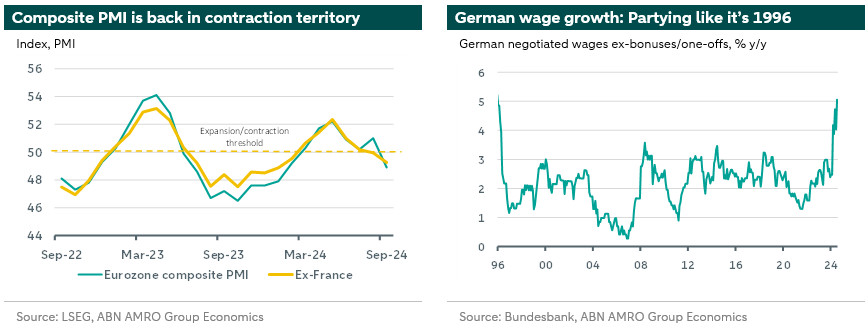Eurozone - Recovery is in peril


The eurozone recovery is in danger of stalling, if it has not already. If weak demand continues, businesses may start to shed workers on a bigger scale, raising the risk of a downturn. Despite weak activity, wage growth remains elevated, posing a dilemma for the ECB. An October rate cut remains our base case. The darkening growth outlook makes that much more likely.
The eurozone recovery is entering a pivotal phase. As this month’s Global View argues, there are good reasons to expect domestic demand to improve over the coming months. But the September PMIs – even accounting for the Paris Olympics distortions – suggest that there are limits to how long businesses can hold out for a recovery. Aside from the general weakness in demand and output that the PMIs signaled, the most worrying news for us concerned employment, with the subindices suggesting that businesses may be about to start letting go of workers on a bigger scale than seen so far. Employment had been one of the few bright spots of the eurozone economy in recent years, as businesses hoarded workers in the expectation of a recovery that is now rapidly losing steam. So far, there is little evidence in the hard labour market data of a major shift – the German unemployment rate has risen somewhat but has been stable for the past four months at 6%. However, as the news over Volkswagen has shown, the situation can turn very quickly, and weak demand cannot persist indefinitely without consequences for employment. All told, the increased downside risks to the outlook, and the weakness in Germany in particular, have led us to sharply downgrade our growth expectations for next year to 1.1% from 1.5% previously.
Against the backdrop of a flagging recovery, inflation risks have not fully diminished. As indicated by the sharp falls in France and Spain this morning, headline inflation for the eurozone is likely to come in well below the 2% target in September (we expect 1.7%), as lower oil prices feed through to petrol prices. But, although services inflation is also expected to cool, it remains elevated. Indeed, the main determinant of services inflation – wage growth – picked up again over the past month, in contrast to the sharp fall in the closely-watched Q2 negotiated wages release. The Indeed monthly wage tracker for the eurozone picked up to 4.1% y/y in August – the highest reading since last November, and well above the 3.4% trough set in May. German negotiated wage growth also rebounded sharply in July to 10.6% y/y; the more stable underlying measure that excludes bonuses and one-offs also accelerated, to 5.1% from 4% in June, the highest since the mid-90s. Such elevated wage readings look incredibly unlikely to persist in such a weak growth environment, and with the threat of job losses looming. But for the time being, these developments continue to pose upside risks to the services inflation outlook.
Momentum is building for an October rate cut
The combination of recession-like activity indicators and strong wage growth sends a confusing and conflicting set of signals for the ECB. GC members will have to decide whether to look through high wage growth and services inflation as lagging indicators, and weigh this against the downside risks to the growth outlook. Our base case has long been that the ECB would follow September’s 25bp rate cut with an additional cut in October, but signals around the September meeting had suggested a high bar to move again already in October. The darkening in the growth outlook has likely significantly changed that calculus, and markets now price an 80% probability of an October move, compared with just a 20% probability last week.
